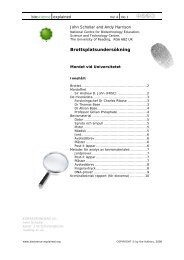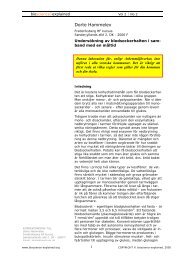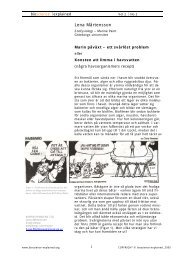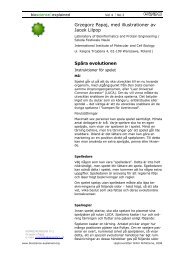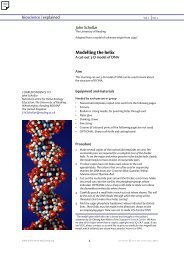Chris Atkinson - Bioscience Explained
Chris Atkinson - Bioscience Explained
Chris Atkinson - Bioscience Explained
- No tags were found...
Create successful ePaper yourself
Turn your PDF publications into a flip-book with our unique Google optimized e-Paper software.
ioscience⏐explained Vol 3 ⏐ No 1<strong>Chris</strong> <strong>Atkinson</strong>Director, European Schools Model European Community Programme& Philosophy teacher, European School, LuxembourgRole-playing SimulationsA brief description of role playing as an educational techniqueCORRESPONDENCE TO<strong>Chris</strong> <strong>Atkinson</strong>Email: christopher.atkinson@education.luSome Preliminary RemarksAll too often, school students whoare politically and ethically “aware”rush into opinions.The majority have liberal, idealisticand generous views – this is refreshingin our world of “Realpolitik”. Butthey often fall short in their knowledgeof the “facts of the case”. Andall too often, they are dismissive ofthe opinions of others.This is a perfectly understandableconsequence of “being a schoolpupil” and yet it shows a certainnaiveté which needs addressing.Role-Playing Simulations are increasinglyused for educational purposes– the idea is for students to seeissues from a wide variety of perspectivesby forwarding opinions which are not necessarily theirown.Role-playing can successfully be used both on a large and smallscale and specifically in the field of politics. However there is noreason why it cannot be extended to deal with purely moral topics,particularly those raised by recent advances in science.With increasing capacity of humans to control their own environmentand thus their destiny, the biologist cannot escape themoral issues that science opens up. Nature is increasingly influencedby the new techniques which biology and related scienceshave made possible. The more mankind can understand the greaterthe extent to which it can control its own future and evolution.“Brave New World” by Huxley was little more than a hypotheticalamusement on publication - now governments are legislatingon measures which may lead to its realisation. To take butone example, stem cell research is now being put “to the people”.It is imperative that students know why a serious disparity ofviews exists on such matters and role-playing is a good way creatingan understanding.In these simulations, participants are more or less randomly assignedto relevant “interest groups” and have to argue on theirbehalf, irrespective of their own views.The procedure is a simple one:-1www.bioscience-explained.org COPYRIGHT © bioscience-explained, 2006
ioscience⏐explained Vol 3 ⏐ No 1• The teacher picks the issue (ethical issue of, for examplecloning, stem-cell research, xenotransplantations, seealso later in the text).• The teacher lists (with the help of the students) the differentinterest groups/schools of thought involved (forexample Catholic church, political parties, animal rightsgroup). (Appendix – Interest groups)• The teacher allocates the roles (see later comment inmain body of the text).• The teacher decides which “forum” is to be simulated(United Nations/National Parliament/European Council/MunicipalCouncil) and then allocates participants tothe different committees. (Appendix – Committees).Each participant is assigned to one of the different committeeswith their own specific debating topics to discuss. The committeechair(person) then reports the findings of the group discussion tothe concluding Plenary Session where a “final” vote is taken.If you pick an issue from natural sciences; like cloning, stem-cellresearch, xenotransplantation, abortion etc you can chose differentgroups like:1. Vatican Ethics Committee2. (Atheistic) humanist Group3. Human/Animal Rights Group4. Pro-eugenics Group5. Left Wing Political Party6. Right wing Political Party7. Lawyers8. Research ScientistsThe sessions need preparation – some of the materials should besupplied beforehand to all participants for example: -1. A dossier is compiled with the “facts” about the issue, includinga summary of alternative views. Alternatively the participantsare asked to find material themselves from the libraryor/and the web.2. Guidelines are provided to committee chair people.3. Assignation of participants to interest groups and committees(Appendices). Either the teacher designates these or allowsthe students to choose. The former is better becausethe students may choose groups with views close to theirown and that defeats the purpose of the exercise!What do participants get out of this? Most importantly it helpsthem understand the views of others. Instead of dismissing opponents’arguments out of hand, school pupils realise that othershave very different paradigms or “world views”. If they want theirown views to prevail through the use of argument, then theymust be acquainted with their opponents’ fundamental beliefsfor it is these which result in the opinions they contest. AsHarper Lee writes in “To Kill a Mocking Bird”2www.bioscience-explained.org COPYRIGHT © bioscience-explained, 2006
ioscience⏐explained Vol 3 ⏐ No 1“You never really understand a person until you consider thingsfrom his point of view…until you climb into his skin and walkaround in it.”A science teacher and philosophy teacher can make a very goodteam as the philosopher can be helping the scientist to see the“wood” as well as the “trees” – the two disciplines can play complementaryroles in simulations, one emphasising the moral sideand the other the technical.The lion’s share of the teacher’s (and students’) work is done beforethe exercise. The crucial role of the organising teacher is todirect the students in vital preparatory research. During thesimulation itself, the teachers should simply observe (and enjoy!)the fruits of their labours.The PracticalitiesIntroduction1. Explain the concept of “role playing” to the class—they willfind it strange at first that they are not able to express their ownviews but only the views of others. However they adapt very easilyto this, much more easily than adults!2. Draw up a list of “interest groups” (for example, for Cloningthis might include; the Vatican, Eugenics group, Left wing party,Human rights specialists, Animal rights militants, Legal expertsetc).3. Divide the class up into groups. The number of groupsshould obviously be the same as the number of interest groupsyou would like represented. In our cloning example, there are sixinterest groups, so in a class of 30, there would be 5 pupils ineach group.4. Tell these groups which interest group they have to support—donot allow them to choose! (see above). My advice is notto manipulate the allocation so that you have mixtures of activeand passive students—if anything, create groups of purely passivestudents (they will become “active” surprisingly quickly!). Allocatethe passive groups to the extremists, the active groups tothe moderates.5. Prepare and present the proposals (i.e. burning questionswhich characterise the issue, e.g. Is it right to clone animals? Is itright to clone humans? Is it wrong to interfere with the “natural”order of things?). In a short simulation, there would probably beonly one proposal to be discussed by each committee. Eachcommittee is composed of one member of each interest group sothat all views are represented. In our example, there wouldtherefore be five committees of six members.6. Get the students to research all issues involved—theywon’t do well unless they are well informed! The Internet is theobvious resource but if there is time the “real” interest groupscan be contacted and consulted.The Role-playPrepare an afternoon programme in the following way:3www.bioscience-explained.org COPYRIGHT © bioscience-explained, 2006
ioscience⏐explained Vol 3 ⏐ No 1Picture 1. General plenary introducionPicture 2. Committee meeting1. General plenary introduction (but in role playing mode—parliament, United Nations, Court of Human Rights etc). Formalintroduction run by student (see below). (Picture 1).2. Hold committee meetings in separate rooms. Their goal isto reach a consensus on their proposal. Each interest group shouldprovide a “chairperson” for one of the committees and eachshould provide a “rapporteur” (= writer of minutes, the record ofthe debate) but of course they should not sit on the same committee.(Picture 2).3. Time in the programme should also be provided for interestgroups to meet together to harmonise their policies.4. 2nd plenary session. Each chairman reports on his/hercommittee results. (Picture 3)5. Each proposal is briefly discussed in a third and final plenarysession (so that members of other committees can contributeif they wish) and a final vote is taken on each of them. TheProposal becomes law if it gets 2/3 vote? (you can decide thesedetails!) (Picture 3)• N.B. Programme a couple of “coffee breaks” and evenlunch - you’ll probably find they will continue to discussthe issues during these!• You should have as LITTLE to do with the session as possible(sit back and enjoy it!). Get a good student to runthe plenaries?• It is of course possible to devise a shorter role-play so itfits into a couple of lessons, but a whole afternoonmakes the play more realistic. The role playing exercisesI run at the European Schools run for two days!Examples of possible issues for discussionsIt is very important that the students have gathered lots of informationbeforehand. Here of course the teacher could helpwith literature and web-addressesPicture 3. ”2nd plenary sessionHuman cloningWhy clone? Why ban cloning? (Consider also ethical aspects)Some people might want to clone to produce a child with certaincharacteristics, e.g. a copy of themselves.Some might want to clone to help supply a sister or brother withan organ.Scientists might want to clone in order to learn as much as possibleabout how genes and environment affect the developmentof an organism from embryo to adulthood.A committee might want to decide which ethical considerationsneed to be addressed now that cloning is technically possible?Should it be allowed to use aborted human embryos for cloning?Should it be allowed to use embryonic stem cells from fertilisedhuman eggs that anyway are going to be thrown away?Cloning controversies raise fundamental questions about howtechnology affects our lives and what it means to be human. Are4www.bioscience-explained.org COPYRIGHT © bioscience-explained, 2006
ioscience⏐explained Vol 3 ⏐ No 1there reasons to believe that cloning will lead to a “Brave NewWorld” scenario? Would a human clone be treated differentlythan other people? Should the government control cloning research?Animal cloningWhy clone? Why ban cloning?When you have a suitable animal for some reason you want toclone that animal. It can be a cow which provides a good milk yieldor a horse that runs fast or a pig that has organs suitable forxenotransplants to humans. Is this ethical?What ethical considerations need to be addressed in the cloningof animals?PowerPoint illustrations: CommitteesPowerpoint illustrations: Interest groups5www.bioscience-explained.org COPYRIGHT © bioscience-explained, 2006




